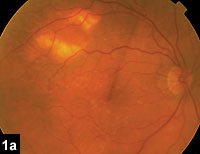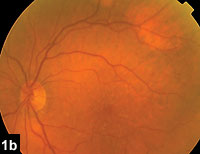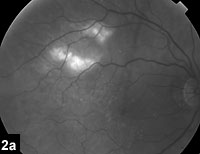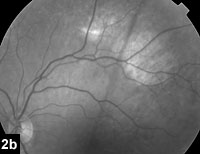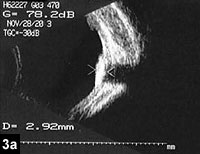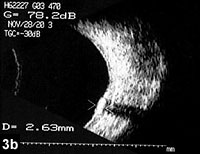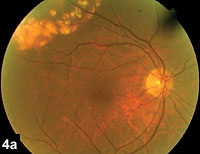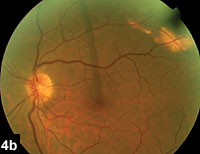Case report: Sclerochoroidal calcification and its significance
Two elderly patients were referred with decreasing vision. Fundus lesions were found in both patients.
Case 1: History
A 97-year-old white man was referred to the ophthalmology department by his optometrist for bilateral cataracts. His medical history included hypertension and osteoarthritis.
Examination
Blood pressure was 130/72 mm Hg.
His best corrected visual acuity was 20/40 in each eye. Anterior segment evaluation confirmed nuclear sclerosis in both eyes.
IOP was 16 mm Hg in the right eye and 18 mm Hg in the left eye. Fundus examination revealed multifocal, yellowish, raised subretinal lesions above the superior temporal arcades in both eyes. The lesions showed autofluorescence with red-free filter.
As the lesions appeared solid, fluorescein angiography was withheld.
B-scan ultrasonography revealed the lesions to be extremely echo dense with high reflectivity at the sclerochoroidal interface and posterior orbital shadowing. Maximum thickness of lesions was 2.92 mm in right eye and 2.63 mm in the left eye.
Follow-up of 12 months has revealed no change.
Case 1
|
|
|
Case 2: History
A 78-year-old white woman came to the ophthalmology department complaining of gradually progressive decreased vision in both eyes for 6 months.
Her medical history included bronchial adenocarcinoma of the right apex. She had received radiotherapy 6 months prior and recently completed a course of systemic steroids.
She was currently not on any medication.
Examination
The patient’s BCVA was 20/30 in the right eye and 20/20 in the left eye.
Anterior segment examination was normal.
IOP was 15 mm Hg in both eyes.
Fundus examination revealed bilateral, yellowish, raised, multifocal subretinal lesions above the superior temporal arcades. Red-free fundal photographs and B-scan ultrasonography features were similar to those of the previous case. Maximum thickness of the fundal lesions on B-scan was 2.02 mm in the right eye and 2.22 mm in the left eye. Follow-up of 18 months has revealed no change.
Case 2
Images: Kadyan A |
Investigations
Both patients had the following blood investigations: full blood count, urea electrolytes, serum calcium, corrected calcium, phosphate, magnesium, urate, alkaline phosphatase, albumin, uric acid and parathyroid hormone to assess the calcium metabolism and the renal functions.
Case 1: The full blood count, calcium, corrected calcium, phosphate and magnesium were within normal range. But parathyroid hormone levels were elevated, as were the potassium, urea, creatinine and alkaline phosphatase, indicative of renal function impairment with secondary hyperparathyroidism.
Case 2: All investigations for calcium metabolism and renal functions were within the normal range.
Discussion
The differential diagnosis for the two elderly patients with incidental findings of bilateral subretinal lesions along superior temporal vessels includes choroidal osteoma, choroidal metastasis, subepithelial infiltrates of large cell ocular lymphoma, amelanotic nevus/melanoma, chorioretinitis and sclerochoroidal calcification.
Choroidal osteoma is the most common differential diagnosis on basis of ultrasound features, which were characteristic of calcification. Choroidal osteomas are rare, benign ossifying tumors seen in younger females (90%) and are unilateral (75%), unifocal lesions at the posterior pole near the disc. They rarely have elevation of more than 2 mm.
Choroidal metastasis is an important differential, and the most common primary sites are breast in women and bronchus in both sexes. The lesions may be solitary or multiple and can be bilateral in 30% of cases. They are usually fast-growing and associated with exudative retinal detachment, although they may initially be asymptomatic if located away from macula. Ultrasonography shows diffuse choroidal thickening with moderate to high reflectivity and variable acoustic structure due to intralesion cystic spaces.
Amelanotic nevus/melanoma usually manifests as unilateral and unifocal lesions.
Ultrasonography shows low internal reflectivity and a regular acoustic structure attributed to the highly cellular structure and lack of intralesional interfaces. They are almost never associated with calcification.
Intraocular lymphoma can present with subretinal infiltration. The lesions are multifocal, yellowish plaques with overlying solid RPE detachment. Ultrasound examination is useful, as there are no signs of calcification.
Ocular calcification can be seen with ossification (bone formation) or calcium salt deposition.
Dystrophic calcification occurs with normal calcium phosphate metabolism in abnormal tissues. The calcium deposition with abnormal calcium phosphate metabolism is known as metastatic calcification. Idiopathic calcification is described with normal calcium phosphate metabolism and normal ocular structure.
Idiopathic sclerochoroidal calcification is described in a few case series previously. It manifests as bilateral, multiple, asymmetric, yellowish subretinal lesions located most often in fundus midperiphery with a predilection for the superotemporal quadrant. Seen in elderly (median age 70 years) white patients, it is usually an incidental finding. Long-term follow-up has shown the lesions to mostly remain unchanged and to be of little visual consequence due to their location.
Diagnosis
Case 1: Metastatic sclerochoroidal calcification due to secondary hyperparathyroidism.
Case 2: Idiopathic sclerochoroidal calcification.
Significance
Sclerochoroidal calcification is a rare entity but important to recognize so as to avoid unnecessary investigation and intervention.
Investigation of calcium phosphorus metabolism and renal functions to determine cause of ocular calcification and detect treatable systemic associations, such as renal tubular hypokalemic alkalosis syndromes, is important. To our knowledge, this is the second reported case of sclerochoroidal calcification with secondary hyperparathyroidism. It also highlights the importance of not relying on screening patients with serum calcium alone, as previously suggested.
The natural course in the majority of patients is benign, but visual loss secondary to choroidal neovascularization and location (macula) has been reported. Patients should be advised on importance of regular self-assessment of vision and annual ophthalmic review. Literature review of 80 reported cases of sclerochoroidal calcification was associated with choroidal neovascularization in three cases. All cases reported with CNV were secondary to metastatic calcification secondary to hyperparathyroidism. This suggests worse prognostic significance of sclerochoroidal calcification secondary to hyperparathyroidism.
For Your Information:References:
- Anju Kadyan, MS, FRCS (Edinburgh), can be reached at 34 The Spinney, Finchfield, Wolverhampton, WV3 9EX, United Kingdom; e-mail: anjukadyan@blueyonder.co.uk.
- Honavar SG, Shields CL, Demirci H, Shields JA. Sclerochoroidal calcification: clinical manifestations and systemic associations. Arch Ophthalmol. 2001;19:833-840.
- Schachat AP, Robertson DM, et al. Sclerochoroidal calcification. Arch Ophthalmol. 1992;110:196-199.
- Cohen SY, Guyot-Sionnest M, Puech M. Choroidal neovascularization as a late complication of hyperparathyroidism. Am J Ophthalmol. 1998;126:320-322.
- Zaman AG, Spalton DJ. Visual loss in metastatic sclerochoroidal calcification. Eye. 1995;9:655-657.
- Leys A, Stalmans P, Blanckaert J. Sclerochoroidal calcification with choroidal neovascularization. Arch Ophthalmol. 2000;118:854-857.

